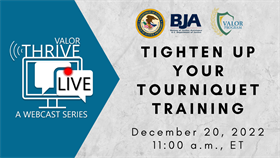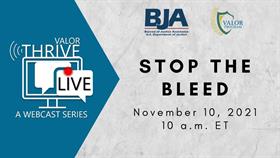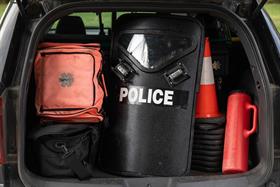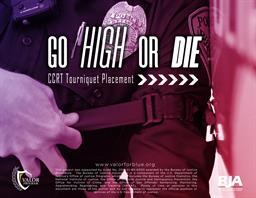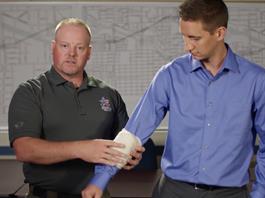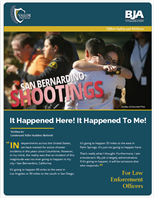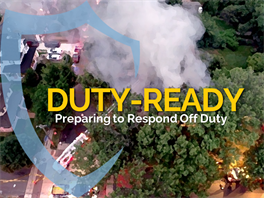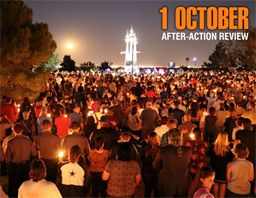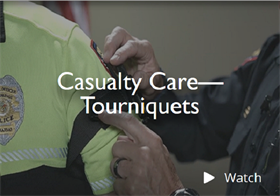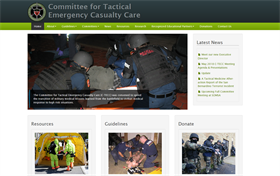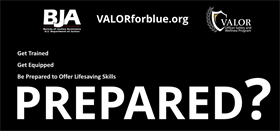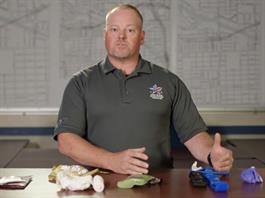VALOR On-Site Training
VALOR training, offered as a one- or two-day course, provides law enforcement with an introduction into some of the most important casualty care principles. To find a training near you, visit Training Events - VALOR for Blue.
If you have already attended a VALOR training, you are eligible to request a Casualty Care and Rescue Tactics four-hour supplemental training to be held on-site at your agency, open to any sworn law enforcement. This training involves hands-on training covering all the equipment and principles featured in the toolkit. To request this training, please visit our Contact Us page.
Other On-Site Training Opportunities:
- If your agency has already received all the VALOR training on Casualty Care, you can visit https://www.naemt.org/education/naemt-tccc . The National Association of Emergency Medical Technicians offers a wide array of in-depth trainings and certifications for Tactical Combat Casualty Care.
Casualty Care Resource Clearinghouse
The Casualty Care Resource Clearinghouse is your one-stop-shop for all VALOR casualty care resources. All the resources available on the other pages can be found here as well as a multitude of others.
View All Resources
-
Thrive: Episode 13 — Tighten Up Your Tourniquet Training
To render effective medical aid, you must have the proper equipment and know how to use it. Your tourniquet is an essential part of your equipment. Join Chief David Flory (retired) and Paramedic Corporal Laura Hill in an interactive virtual learning environment to discuss important tips for...
-
Thrive: Episode 2 — Stop the Bleed
In this episode, Chief David Flory (retired) sits down with Mr. David Dunafan and Officer Taylor Brandt, who will discuss the importance of training and equipment when it comes to casualty care and rescue tactics. They will discuss how having the proper training and equipment gives you the...
-
Staging Equipment for Mass Gatherings
There are numerous benefits of pre-staging equipment for mass gatherings to increase responsiveness to potential critical incidents. In this episode, Chief Richard Beary (Retired) from the University of Central Florida joins VALOR Program instructor Floyd Wiley to share some lessons he has learned...
-
Go High or Die
It is important to understand how to administer a tourniquet and train regularly in various situations to administer it quickly and effectively. Go high or die: Apply a tourniquet by placing it on the highest point of the injured extremity, regardless of the location of the injury. You are...
-
Go High or Die
Proper placement can mean the difference between life and death. The life you save could be your own.
-
Applying a Pressure Dressing
This video demonstrates how to apply a pressure dressing.
-
Thrive: Episode 13 — Tighten Up Your Tourniquet Training
To render effective medical aid, you must have the proper equipment and know how to use it. Your tourniquet is an essential part of your equipment. Join Chief David Flory (retired) and Paramedic Corporal Laura Hill in an interactive virtual learning environment to discuss important tips for...
-
Thrive: Episode 2 — Stop the Bleed
In this episode, Chief David Flory (retired) sits down with Mr. David Dunafan and Officer Taylor Brandt, who will discuss the importance of training and equipment when it comes to casualty care and rescue tactics. They will discuss how having the proper training and equipment gives you the...
-
Staging Equipment for Mass Gatherings
There are numerous benefits of pre-staging equipment for mass gatherings to increase responsiveness to potential critical incidents. In this episode, Chief Richard Beary (Retired) from the University of Central Florida joins VALOR Program instructor Floyd Wiley to share some lessons he has learned...
-
Go High or Die
It is important to understand how to administer a tourniquet and train regularly in various situations to administer it quickly and effectively. Go high or die: Apply a tourniquet by placing it on the highest point of the injured extremity, regardless of the location of the injury. You are...
-
Go High or Die
Proper placement can mean the difference between life and death. The life you save could be your own.
-
Applying a Pressure Dressing
This video demonstrates how to apply a pressure dressing.
-
Dress For Success - Gear Readiness
The equipment you carry could be the difference between life and death. It is vital that your gear is always in good working order and accessible. How you train is how you perform in high-stress situations. Train for entering and exiting your vehicle tactically and accessing the items on your...
-
It Happened Here! It Happened To Me!
This article tells the story of Lieutenant Mike Madden and his personal experience as the first officer on scene at the Inland Regional Center active shooter attack in San Bernardino, California. He describes how decisions he made before starting his shift affected his safety.
-
Duty Ready: Preparing to Respond Off Duty
This online training module discusses an off-duty active shooter incident and key considerations for responding off duty. Topics discussed include having a plan for your family, quickly accessing your equipment, planning your route of approach, and what to do if your equipment malfunctions.
-
Thrive: Episode 13 — Tighten Up Your Tourniquet Training
To render effective medical aid, you must have the proper equipment and know how to use it. Your tourniquet is an essential part of your equipment. Join Chief David Flory (retired) and Paramedic Corporal Laura Hill in an interactive virtual learning environment to discuss important tips for...
-
Thrive: Episode 2 — Stop the Bleed
In this episode, Chief David Flory (retired) sits down with Mr. David Dunafan and Officer Taylor Brandt, who will discuss the importance of training and equipment when it comes to casualty care and rescue tactics. They will discuss how having the proper training and equipment gives you the...
-
Staging Equipment for Mass Gatherings
There are numerous benefits of pre-staging equipment for mass gatherings to increase responsiveness to potential critical incidents. In this episode, Chief Richard Beary (Retired) from the University of Central Florida joins VALOR Program instructor Floyd Wiley to share some lessons he has learned...
-
Go High or Die
It is important to understand how to administer a tourniquet and train regularly in various situations to administer it quickly and effectively. Go high or die: Apply a tourniquet by placing it on the highest point of the injured extremity, regardless of the location of the injury. You are...
-
Go High or Die
Proper placement can mean the difference between life and death. The life you save could be your own.
-
Applying a Pressure Dressing
This video demonstrates how to apply a pressure dressing.
-
Dress For Success - Gear Readiness
The equipment you carry could be the difference between life and death. It is vital that your gear is always in good working order and accessible. How you train is how you perform in high-stress situations. Train for entering and exiting your vehicle tactically and accessing the items on your...
-
It Happened Here! It Happened To Me!
This article tells the story of Lieutenant Mike Madden and his personal experience as the first officer on scene at the Inland Regional Center active shooter attack in San Bernardino, California. He describes how decisions he made before starting his shift affected his safety.
-
Duty Ready: Preparing to Respond Off Duty
This online training module discusses an off-duty active shooter incident and key considerations for responding off duty. Topics discussed include having a plan for your family, quickly accessing your equipment, planning your route of approach, and what to do if your equipment malfunctions.
-
Las Vegas Police Department After-Action Review
This publication documents the events of the Las Vegas, Nevada, mass shooting and contains good insights and recommendations that go well beyond the operational police response, to include emergency management, internal communications, and dispatching and external communications.
-
WIN - Get Off the X
Fight, move, communicate.
-
Officer and Community Wellness Resources for Law Enforcement
This toolkit was curated by the Public Safety Partnerships team to provide a suite of timely resources dedicated to assisting our law enforcement partners with best practices for building community trust, strengthening relationships, and increasing cultural understanding with diverse communities....
-
Casualty Care—Tourniquets
This online training is designed to review the Tactical Combat Casualty Care-recommended tourniquets and demonstrate to officers how to apply each of these tourniquets on themselves and on others to prevent major blood loss.
-
Committee for Tactical Emergency Casualty Care
Web page provides resources, guidelines, research, and news updates for managing casualty care during high-threat operations.
-
Post Critical-Incident Trauma Care
Flight paramedic and former law enforcement officer Brian Lankford shares his lessons learned rendering medical aid in the field, highlighting the need for casualty care in law enforcement, as well as how to implement effective casualty care procedures in agencies.
-
Are You Prepared?
Critical incidents can happen anywhere, anytime. Are you trained and prepared to respond?
-
Essential Casualty Care Equipment for Your Go-Bag
In this video, the essential casualty care equipment for a law enforcement officer's go-bag is reviewed.
-
Thrive: Episode 13 — Tighten Up Your Tourniquet Training
To render effective medical aid, you must have the proper equipment and know how to use it. Your tourniquet is an essential part of your equipment. Join Chief David Flory (retired) and Paramedic Corporal Laura Hill in an interactive virtual learning environment to discuss important tips for...
-
Thrive: Episode 2 — Stop the Bleed
In this episode, Chief David Flory (retired) sits down with Mr. David Dunafan and Officer Taylor Brandt, who will discuss the importance of training and equipment when it comes to casualty care and rescue tactics. They will discuss how having the proper training and equipment gives you the...
-
Staging Equipment for Mass Gatherings
There are numerous benefits of pre-staging equipment for mass gatherings to increase responsiveness to potential critical incidents. In this episode, Chief Richard Beary (Retired) from the University of Central Florida joins VALOR Program instructor Floyd Wiley to share some lessons he has learned...
-
Go High or Die
It is important to understand how to administer a tourniquet and train regularly in various situations to administer it quickly and effectively. Go high or die: Apply a tourniquet by placing it on the highest point of the injured extremity, regardless of the location of the injury. You are...
-
Go High or Die
Proper placement can mean the difference between life and death. The life you save could be your own.
-
Applying a Pressure Dressing
This video demonstrates how to apply a pressure dressing.
-
Dress For Success - Gear Readiness
The equipment you carry could be the difference between life and death. It is vital that your gear is always in good working order and accessible. How you train is how you perform in high-stress situations. Train for entering and exiting your vehicle tactically and accessing the items on your...
-
It Happened Here! It Happened To Me!
This article tells the story of Lieutenant Mike Madden and his personal experience as the first officer on scene at the Inland Regional Center active shooter attack in San Bernardino, California. He describes how decisions he made before starting his shift affected his safety.
-
Duty Ready: Preparing to Respond Off Duty
This online training module discusses an off-duty active shooter incident and key considerations for responding off duty. Topics discussed include having a plan for your family, quickly accessing your equipment, planning your route of approach, and what to do if your equipment malfunctions.
-
Las Vegas Police Department After-Action Review
This publication documents the events of the Las Vegas, Nevada, mass shooting and contains good insights and recommendations that go well beyond the operational police response, to include emergency management, internal communications, and dispatching and external communications.
-
WIN - Get Off the X
Fight, move, communicate.
-
Officer and Community Wellness Resources for Law Enforcement
This toolkit was curated by the Public Safety Partnerships team to provide a suite of timely resources dedicated to assisting our law enforcement partners with best practices for building community trust, strengthening relationships, and increasing cultural understanding with diverse communities....
-
Casualty Care—Tourniquets
This online training is designed to review the Tactical Combat Casualty Care-recommended tourniquets and demonstrate to officers how to apply each of these tourniquets on themselves and on others to prevent major blood loss.
-
Committee for Tactical Emergency Casualty Care
Web page provides resources, guidelines, research, and news updates for managing casualty care during high-threat operations.
-
Post Critical-Incident Trauma Care
Flight paramedic and former law enforcement officer Brian Lankford shares his lessons learned rendering medical aid in the field, highlighting the need for casualty care in law enforcement, as well as how to implement effective casualty care procedures in agencies.
-
Are You Prepared?
Critical incidents can happen anywhere, anytime. Are you trained and prepared to respond?
-
Essential Casualty Care Equipment for Your Go-Bag
In this video, the essential casualty care equipment for a law enforcement officer's go-bag is reviewed.
-
Thrive: Episode 13 — Tighten Up Your Tourniquet Training
To render effective medical aid, you must have the proper equipment and know how to use it. Your tourniquet is an essential part of your equipment. Join Chief David Flory (retired) and Paramedic Corporal Laura Hill in an interactive virtual learning environment to discuss important tips for...
-
Thrive: Episode 2 — Stop the Bleed
In this episode, Chief David Flory (retired) sits down with Mr. David Dunafan and Officer Taylor Brandt, who will discuss the importance of training and equipment when it comes to casualty care and rescue tactics. They will discuss how having the proper training and equipment gives you the...
-
Staging Equipment for Mass Gatherings
There are numerous benefits of pre-staging equipment for mass gatherings to increase responsiveness to potential critical incidents. In this episode, Chief Richard Beary (Retired) from the University of Central Florida joins VALOR Program instructor Floyd Wiley to share some lessons he has learned...
-
Go High or Die
It is important to understand how to administer a tourniquet and train regularly in various situations to administer it quickly and effectively. Go high or die: Apply a tourniquet by placing it on the highest point of the injured extremity, regardless of the location of the injury. You are...
-
Go High or Die
Proper placement can mean the difference between life and death. The life you save could be your own.
-
Applying a Pressure Dressing
This video demonstrates how to apply a pressure dressing.
-
Dress For Success - Gear Readiness
The equipment you carry could be the difference between life and death. It is vital that your gear is always in good working order and accessible. How you train is how you perform in high-stress situations. Train for entering and exiting your vehicle tactically and accessing the items on your...
-
It Happened Here! It Happened To Me!
This article tells the story of Lieutenant Mike Madden and his personal experience as the first officer on scene at the Inland Regional Center active shooter attack in San Bernardino, California. He describes how decisions he made before starting his shift affected his safety.
-
Duty Ready: Preparing to Respond Off Duty
This online training module discusses an off-duty active shooter incident and key considerations for responding off duty. Topics discussed include having a plan for your family, quickly accessing your equipment, planning your route of approach, and what to do if your equipment malfunctions.
-
Las Vegas Police Department After-Action Review
This publication documents the events of the Las Vegas, Nevada, mass shooting and contains good insights and recommendations that go well beyond the operational police response, to include emergency management, internal communications, and dispatching and external communications.
-
WIN - Get Off the X
Fight, move, communicate.
-
Officer and Community Wellness Resources for Law Enforcement
This toolkit was curated by the Public Safety Partnerships team to provide a suite of timely resources dedicated to assisting our law enforcement partners with best practices for building community trust, strengthening relationships, and increasing cultural understanding with diverse communities....
-
Casualty Care—Tourniquets
This online training is designed to review the Tactical Combat Casualty Care-recommended tourniquets and demonstrate to officers how to apply each of these tourniquets on themselves and on others to prevent major blood loss.
-
Committee for Tactical Emergency Casualty Care
Web page provides resources, guidelines, research, and news updates for managing casualty care during high-threat operations.
-
Post Critical-Incident Trauma Care
Flight paramedic and former law enforcement officer Brian Lankford shares his lessons learned rendering medical aid in the field, highlighting the need for casualty care in law enforcement, as well as how to implement effective casualty care procedures in agencies.
-
Are You Prepared?
Critical incidents can happen anywhere, anytime. Are you trained and prepared to respond?
-
Essential Casualty Care Equipment for Your Go-Bag
In this video, the essential casualty care equipment for a law enforcement officer's go-bag is reviewed.
Frequently Asked Questions
Yes! We encourage you to share the toolkit and all its content with any and all sworn law enforcement officers.
Many of the toolkit’s materials are perfect to use for roll call. We have drill sheets as well as concise training videos that could serve as an important daily reminder before a shift. If your agency does not do roll call before every shift, make sure to touch up on these principles on your own before your shift and make sure to also utilize our printable resources section. Print out some posters and place them around your agency.
The VALOR Program offers in-person training on this topic. If you have attended a VALOR training, you are eligible to request a Casualty Care and Rescue Tactics four-hour supplemental training to be delivered on-site at your agency. This training involves hands-on training in all the equipment and principles featured in the toolkit. To request this training, please visit our Contact Us page. If your agency has already received all the VALOR training on casualty care, you can visit https://www.naemt.org/education/naemt-tccc. The National Association of Emergency Medical Technicians offers a wide array of in-depth trainings and certifications for Tactical Combat Casualty Care (TCCC).
The VALOR Program’s casualty care curriculum and resources are based off the TCCC model. TCCC approves certain brands in the market based on rigorous research and testing on the products, ensuring that they are only endorsing products that will be reliable and effective in the field. Therefore, though there are other products on the market, VALOR features only TCCC-approved products in the toolkit.
